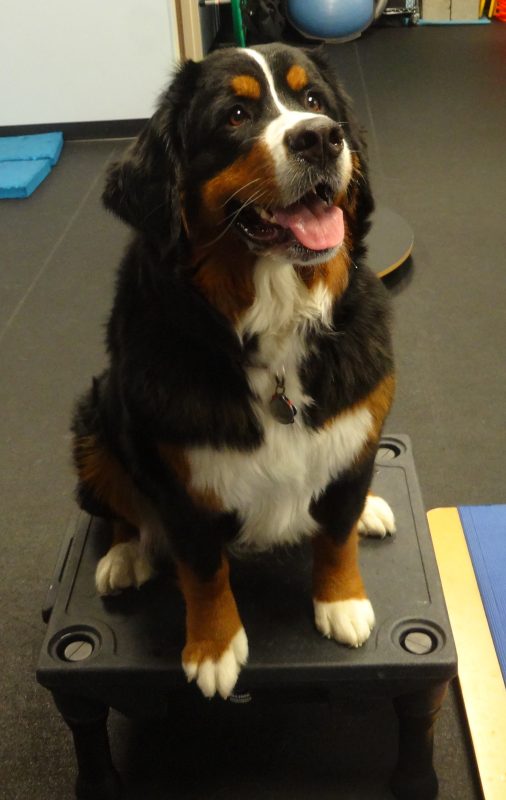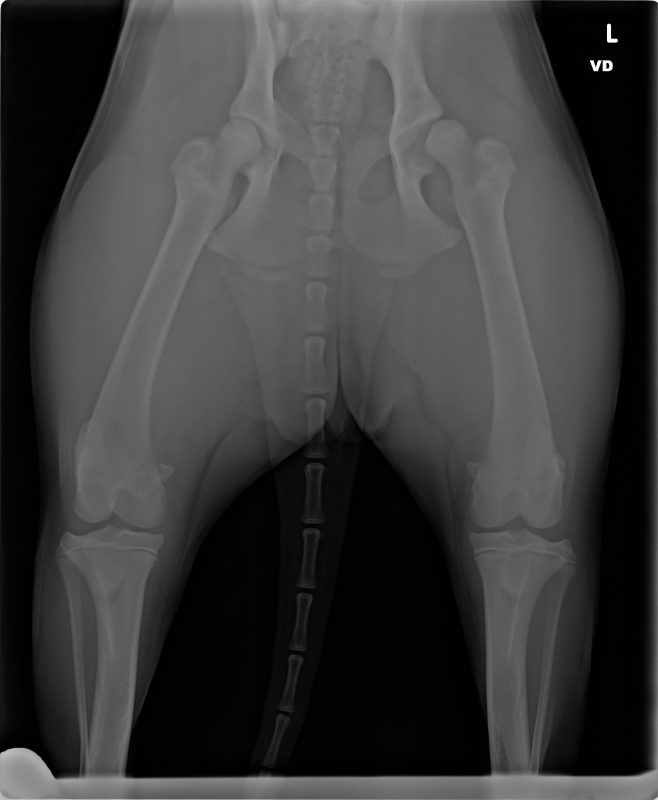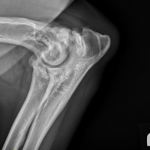Common Canine Congenital Orthopedic Conditions
by Janelle Allen, LVT and Angelia Oliverei, LVT
Unfortunately canine congenital orthopedic conditions are common in the rehabilitation field. A diagnosis of hip dysplasia in a young dog, or puppy can make you feel over whelmed, and helpless. Often thoughts turn to only being able to manage the disease with pain killers or surgery. However, rehabilitation professionals have a lot to offer these young patients, especially when we meet them early in life! Surgery may be avoided and we may even be able to ween them off of pain medications. First, let’s take a look at a few common canine congenital orthopedic conditions that we see. This is a short introduction, as each of these disease processes can take up an entire blog themselves.
Hip Dysplasia

In the x-ray above, the hip joint on the right demonstrates the ball off the femur not seated properly in the socket.
Hip dysplasia is arguably the most common congenital condition seen in rehabilitation. In the simplest terms, hip dysplasia occurs when the ball and socket joint of the hip(s) are not tightly seated together. This condition is often associated with larger breed dogs (i.e.: German Shepherd Dogs, Mastiffs, Labrador Retrievers, and Golden Retrievers), but can also occur in small breed dogs and even cats. Diagnosis of hip dysplasia is made based on symptoms (difficulty rising, pain in the hind limbs, abnormal gait) followed by x-rays of the hips and pelvis.
Medial Patellar Luxation (MPL)
Patellar luxation occurs when the kneecap (patella) slides out of its groove in the bottom of the femur. While the patella can luxate in either direction, medial (towards the middle of the body) is significantly more common. This condition is often found in small breed dogs. Luxating patellas are graded by severity, and rehabilitation may actually lower the frequency of luxation in milder cases.

This x-ray demonstrates elbow dysplasia. Joint edges are very rough.
Elbow Dysplasia
Elbow dysplasia is a blanket term for several conditions involving the elbow joint, including ununited anconeal process (UAP), medial coronoid disease (MCD), and/or osteochondrosis dissicans (OCD). Symptoms include lameness involving one or both front limbs, stiffness, swelling, pain, and decreased range of motion. Many of the symptoms can wax and wane, making diagnosis difficult. Front limb lameness is often more debilitating than lameness in the hind limbs, as dogs carry more weight on their fore limbs. The first step in diagnosing the problem usually includes radiographs. However, advanced diagnostics may be needed.
Congenital Limb Deformity
Congenital deformities are unique to the individual patient. The limb(s) can have one or multiple underdeveloped bones, changes in angles of the bone, or absence of an entire limb. The missing or shortened limbs can cause abnormal gaits and place stress on the spine and other “normal” limbs. While some conditions will require surgery, other patients may benefit from a orthotic, prosthetic, or even a wheelchair to reduce the lifelong stress placed on their bodies.
Rehabilitation Options
Arthritis is an inevitable outcome of any abnormal changes to a joint. However, rehabilitation can slow progression of arthritis in these young pets and provide very good mobility for years. A few options for patients include:
- Pain management is the cornerstone of any rehabilitation treatment plan. The treatments used are based upon severity of pain, disease process, and age of the dog.
- Once pain is well managed, identifying and correcting areas of weakness can be addressed. Strengthening the muscles around a joint with gentle exercise can greatly improve joint stability. Strength training can include targeted exercises and hydrotherapy.
- Assistive devices include orthotics, prosthetics, carts, and supportive harnesses. Some of these devices can be incorporated into a treatment plan while the patient is young to aid them throughout their lives.
- These are only a few of the many options rehabilitation has to offer.
Rehabilitation Provides a Lifetime of Options
Rehabilitation provides beneficial treatment options for canine congenital orthopedic conditions, which can help over the pet’s lifetime. While each case is different, and some surgeries cannot be avoided, rehabilitation can be used in conjunction with surgery and yield better results. With guidance from rehabilitation professionals, young dogs and their families are provided educational support and therapeutic options to improve mobility through their life.
